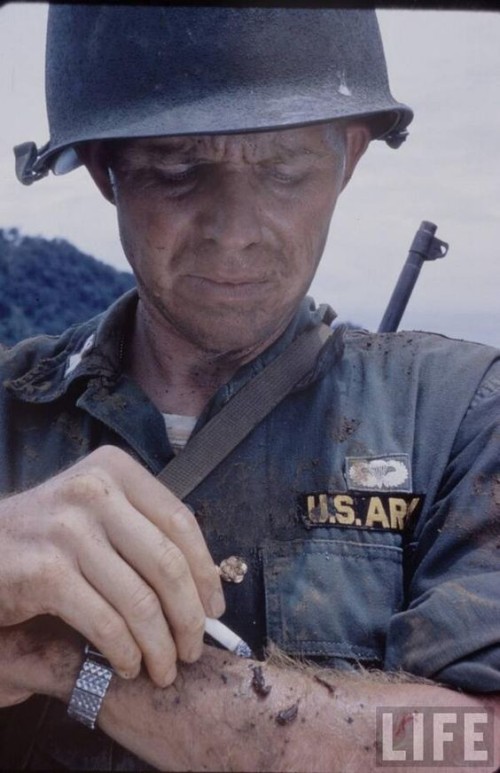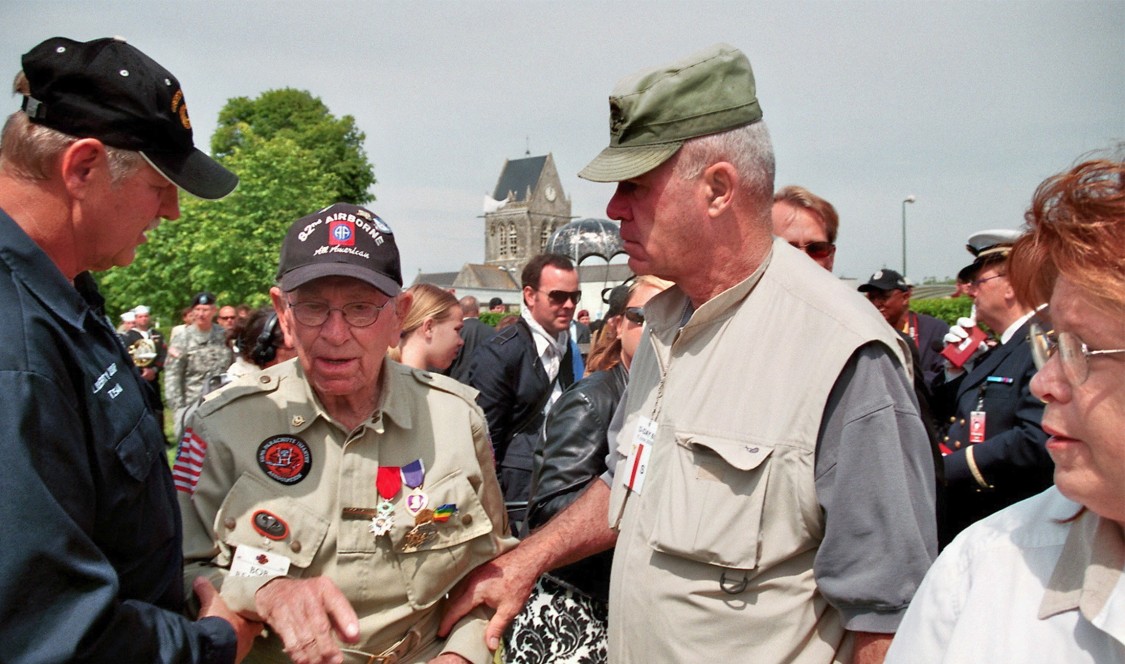What Keith Nightingale ’65 remembers most when he speaks for “the originals,” the soldiers who participated in the Normandy invasion on D-Day, June 6, 1944, is the reflections of those who survived, made it to the top of the cliffs and beaches, and saw the hundreds of bodies lying on the sand and in the water with a long pink stain flowing out with the tide.
Col. (ret.) Keith Nightingale ’65 served with distinction for 28 years in the U.S. Army. He is a decorated combat veteran with two tours in Vietnam, combat operations in Grenada and Panama, counter-drug actions in Latin America, as well as a variety of special operations missions. While his military career offers many exceptional stories of service and valor, Keith’s 58-year commitment to the Normandy invasion offers insights to this officer’s dedication to the memory of that historic event and the lives, service, and sacrifice of soldiers of the 82d Airborne Division who parachuted onto French soil on D-Day, June 6, 1944.
Keith’s first official interaction with Normandy began in 1977 when he made a trip to Normandy to tour the beachheads and battlefields. He was overwhelmed by the degree to which the French expressed their gratitude for the salvation delivered by the paratroopers of the 82nd Airborne Division who risked their lives and began the liberation of their country. Keith quoted one local as saying, “My grandfather looked up and saw all these parachutes and said, ‘These are the angels from heaven.’” The angels were 18- and 19-year-old soldiers who jumped and risked their lives that night. Many remain buried in the hallowed ground of Normandy cemeteries. Keith found the French have a greater understanding of the events of the D-Day invasion than do Americans. This experience caused him to make an unprecedented commitment to ensure the stories and sacrifice of the members of his division endure…those who risked everything on that fateful day.

With an equally committed colleague, Keith began an annual program called “Staff Rides” (tours) bringing tourists and active-duty soldiers from the 82nd and 101st Airborne Divisions back to Normandy to tour the beachheads and battlefields and tell the stories of soldiers who survived the engagements. When he first started, there were a number of “originals” who participated as area guides to tell their battlefield stories at the beaches, cliffs, and bunkers where they fought. Keith listened carefully, and year after year as the number of “originals” declined, he assumed responsibility to speak for them and tell the stories of how they survived.
But this commitment was not sufficient, so in 1983, he began an extremely ambitious proposal to celebrate the 40th anniversary of the 82nd Airborne Division’s parachute jump into Normandy on D-Day. At the time, he was a lieutenant colonel and the battalion commander of the 2/505 Infantry Regiment of the 82nd. He approached the Division Commander General James Lindsay with a proposal to recreate the parachute drop of the division into Normandy on D-Day. The response was: “Yeah, we can do this!” Keith was subsequently introduced to Generals Ridgeway and Gavin (retired but not forgotten), two of the original officers who planned and participated in the invasion. These two generals thoroughly supported Keith’s proposal and worked tirelessly through their military and political contacts in the Army and Washington to clear the hurdles and provide support for the event and ceremony. Through contacts with General Lindsay, the original British Parachute Regiment that participated in the jump also became involved.
The plan called for 350 carefully selected soldiers from the 82nd and 100 from the British Parachute Regiment to recreate the parachute drop on June 6, 1944. The plan was not without its challenges, and a change in the 82d Division leadership created some roadblocks in the plan, but when President Reagan decided to attend and the Secretary of the Army Jack Marsh felt this would be a great opportunity for America to “show the flag,” all opposition disappeared.
The 350 soldiers from the 82nd visited the 100 from the British Parachute Regiment a week before the scheduled jump. They spent time getting to know each other and swapping paratrooper stories. They were visited by a few of “the originals” who told of what it was like on the eve of the original invasion. The British Parachute Regiment was not equipped with enough fixed-wing aircraft to carry the paratroopers across the channel. Consequently, they decided to conduct a number of “balloon blasts.” The UK had a surplus of giant balloons used to discourage German bombers during the raids on London and rigged each with baskets to hold six paratroopers. The balloons were raised to about 500 feet, and the British paratroopers jumped from the baskets using special parachutes that opened at 200 feet above ground.

The 40th anniversary day dawned clear and sunny—a perfect day for a parachute jump. The American soldiers took off in C130 aircraft at 10 in the morning with the doors open. Keith, in full battle gear, parachute on his back, would jump third from the lead aircraft behind the commanding general of the 82d. At 10 minutes before the jump enroute to Normandy, the crew chief from his aircraft tapped him on the shoulder and asked him to come forward to the cockpit to speak with the pilot. Alarmed, Keith waddled forward with all his equipment and met with the pilot who stood up from his seat and informed Keith that he was an Air Force Reserve Officer and genuinely appreciated the effort Keith devoted to organizing the celebration. “He shook my hand, and I was just dumbfounded,” said Keith. “He then told me he had been the flight lead on the real D-Day invasion, and he was now flying the plane back on the 40th anniversary. It was to be his final active-duty flight.”
Keith returned to his seat and, at six minutes before the green light, told the paratroopers to stand and perform equipment checks. He then received word that the French gendarmes could not control the civilians at the drop zone, and they had broken through the barriers and completely flooded the landing zone. “What do you want to do?” asked the ground controller. Keith’s response was, “We’re jumping!”
After Keith exited the plane, he looked up to see that his parachute had fully deployed. He then looked around to make sure he was not too close to any other jumpers. Then he looked down to see thousands of French civilians crowded all over the drop zone. Saying a silent prayer that he would not hit anyone, he prepared to land. No sooner had he hit the ground than a French family surrounded him. The father grabbed his hand, shaking it and crying, little kids pounded him on the back, and the mother knelt crying, her hands in prayer. In truth, every soldier landing that day was blessed by the same experiences.
Keith continues to make annual trips to Normandy. He is imbued with the responsibility to represent and speak for “the originals” from the 82nd Airborne Division who jumped into Normandy. Keith was awarded the French Legion of Honour for his efforts and was made an honorary citizen of the town of Sainte-Mère-Église where the 82nd first jumped on D-Day.
This article reflects only one story of many that Keith tells each time he returns to Normandy. Each time he speaks for “the originals” he feels the chilling battlefield tales related to him. What he remembers most are (1) the incredible sensory deprivation of the soldiers who attacked the beaches on that day—they all experienced extreme battlefield tunnel vision; (2) the profound impact of the destroyers who risked German artillery and very shallow water to navigate close to shore and provide close-in fire support; and (3) the reflections of those soldiers who survived, made it to the top of the cliffs and beaches, and saw the hundreds of bodies lying on the sand and in the water with a long pink stain flowing out with the tide.

